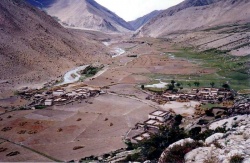Milarepa's Cave
Milarepa's Cave or Namkading Cave is a cave where the great Tibetan Buddhist Philosopher, and Vajrayana Mahasiddha, Milarepa (c. 1052—c. 1135 CE), spent many years of his Life in the eleventh century, 11 km north of the town of Nyalam, below the roadside and above the Matsang River in Nyalam County, Tibet.
There is also a cave associated with Milarepa in Nepal on the Annapurna_Circuit at approximately 4000m just outside of Manang. It is credited to have been the residence of the famous Saint Milarepa during his stay in modern day northern Nepal. This site also includes a holy spring, gompa, and bow from the local archer who met and tried to kill Milarepa. In the classical songs of Milarepa, he sings of a deer, a dog and a hunter, the chain of causation and Compassion. In local tradition this is the site of this famous tale. The cave is located beyond the Gompa, the locals pray from the edge of a glacial moraine in directly line of sight of the cave as its approach directly is on steep scree slope.
Pengyeling Monastery
A Path leads down from the roadside through the village and down a hillside where there is a small Monastery (gompa) named Pelgye Ling, Phelgye Ling or Pengyeling which is built around the cave. The Assembly Hall of the Monastery has a principal image of Padmasambhava.
The Monastery used to be a Kagyupa temple but, since the late 17th century, has been affiliated with the Gelugpa Sera Monastery in Lhasa.
Description of the cave
Milarepa's cave, which overlooks the entrance to the hidden valley of Lapchi Gang, is entered from the gompa's vestibule. Pilgrim's Offerings of decorated stones along the Path and sweet-smelling herbs and wild Flowers growing all around make this a place of great Peace and Beauty. The cave itself is kept as a shrine by two Monks, guarding a statue of Milarepa enclosed in a glass case. In the cave is an impression in the rock attributed to Milarepa's sitting Meditation Posture and a hand print said to have been created when Milarepa helped Rechungpa (1083/4-1161 CE), his student, use a boulder to prop up the ceiling. There are images of Milarepa, Tsongkhapa, and Shri Devi, a protectress whose mule is said to have left a footprint in the stone when she visited Milarepa in a vision.
Restoration work within the cave and the Monastery was undertaken by artists and craftsmen from Nepal and was financed by the Chinese government in the 1970s.
In Art
The cave and the Pelgye Ling temple have been the subject of Richard Gere's artistic photo work, Milarepa's Cave, Nyelam Pelgye Ling Temple, Tibet (1993).

